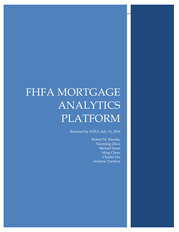Description
References
Case, Karl E. and Robert J. Shiller, “Is There a Bubble in the Housing Market?,”
Brookings Papers on Economic Activity, vol. 34(2), 2003.
Cordell, Larry, Liang Geng, Laurie Goodman and Lidan Yang, “The Cost of
Delay,” Federal Reserve Bank of Atlanta, Working Paper No.
13-15, April, 2013. Dunsky, Robert M. and Thomas S.Y. Ho, “Valuing Fixed Rate Mortgage Loans with Default and Prepayment Options,” The Journal of Fixed Income, 16(4), Spring, 2007. Frame, Scott W., Kristopher Gerardi and Paul S.
Willen, “The Failure of Supervisory Stress Testing: OFHEO’s Risk-Based Capital Model for Fannie Mae and Freddie Mac,” Federal Reserve Bank of Atlanta, Working Paper, December, 2013. Leamer, Edward E., “Housing is the Business Cycle,” Proceedings, Federal Reserve Bank of Kansas City, September, 2007. Smith, Scott and Jesse Weiher, “Countercyclical Capital Regime: A Proposed Design and Empirical Evaluation,” Federal Housing Finance Agency, Working Paper No. 12-2, April, 2012. 34 .
13-15, April, 2013. Dunsky, Robert M. and Thomas S.Y. Ho, “Valuing Fixed Rate Mortgage Loans with Default and Prepayment Options,” The Journal of Fixed Income, 16(4), Spring, 2007. Frame, Scott W., Kristopher Gerardi and Paul S.
Willen, “The Failure of Supervisory Stress Testing: OFHEO’s Risk-Based Capital Model for Fannie Mae and Freddie Mac,” Federal Reserve Bank of Atlanta, Working Paper, December, 2013. Leamer, Edward E., “Housing is the Business Cycle,” Proceedings, Federal Reserve Bank of Kansas City, September, 2007. Smith, Scott and Jesse Weiher, “Countercyclical Capital Regime: A Proposed Design and Empirical Evaluation,” Federal Housing Finance Agency, Working Paper No. 12-2, April, 2012. 34 .
Economic Conditions Sub Categories
FHFA









